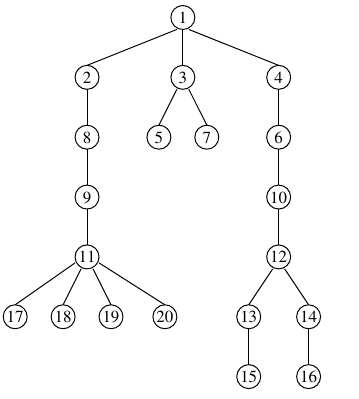
Zadanie Superkomputer (sup)
Pomóż nam usprawnić bazę zadań!
Number of users: 157
Number of users with 100 points: 68
Average result: 55.6306
Supercomputer
Memory limit: 256 MB
Byteasar has designed a supercomputer of novel architecture. It may comprise of many (identical) processing units. Each processing unit can execute a single instruction per time unit.
The programs for this computer are not sequential but rather have a tree structure. Each instruction may have zero, one, or multiple subsequent instructions, for which it is the parent instruction.
The instructions of the program can be executed in parallel on all available processing units. Moreover, they can be executed in many orders: the only restriction is that an instruction cannot be executed unless its parent instruction has been executed before. For example, as many subsequent instructions of an instruction that has been executed already can be executed in parallel as there are processing units.
Byteasar has a certain program to run. Since he likes utilizing his resources optimally, he is wondering how the number of processing units would affect the running time. He asks you to determine, for a given program and number of processing units, the minimum execution time of the program on a supercomputer with this many processing units.
Input
In the first line of standard input, there are two integers,  and
and  (
( ), separated by a single space, that specify the number of
instructions in Byteasar's program and the number of running time queries (for different numbers
of processing units).
), separated by a single space, that specify the number of
instructions in Byteasar's program and the number of running time queries (for different numbers
of processing units).
In the second line of input, there is a sequence of  integers,
integers,  (
( ), separated by single spaces:
), separated by single spaces:  is the number of processing units in
Byteasar's
is the number of processing units in
Byteasar's  -th query.
-th query.
In the third and last input line, there is a sequence of  integers,
integers,  (
( ), separated by single spaces:
), separated by single spaces:  specifies the number of the parent instruction
of the instruction number
specifies the number of the parent instruction
of the instruction number  .
The instructions are numbered with successive integers from 1 to
.
The instructions are numbered with successive integers from 1 to  , where the instruction no. 1
is the first instruction of the program.
, where the instruction no. 1
is the first instruction of the program.
In tests worth 35% of the total score the condition  ,
,  holds.
Moreover, in a subset of those worth 20% of the total score
holds.
Moreover, in a subset of those worth 20% of the total score  ,
,  holds in addition.
holds in addition.
Output
Your program should print one line consisting of  integers, separated by single spaces,
to the standard output:
the
integers, separated by single spaces,
to the standard output:
the  -th of these numbers should specify the minimum execution time of the program on a supercomputer with
-th of these numbers should specify the minimum execution time of the program on a supercomputer with  processing units.
processing units.
Example
For the input data:
20 1 3 1 1 1 3 4 3 2 8 6 9 10 12 12 13 14 11 11 11 11
the correct result is:
8

Explanation:
The program can be executed as follows:
| Time | Instructions | ||||||||||||||||||||||||||||||||
|
|
Sample grading tests:
- 1ocen:
 ,
,  , instruction tree is a path;
, instruction tree is a path;
- 2ocen:
 ,
,  , a small random test;
, a small random test;
- 3ocen:
 ,
,  , all instructions other than
, all instructions other than  are its subsequent instructions;
are its subsequent instructions;
- 4ocen:
 ,
,  , instructions form a complete binary tree;
, instructions form a complete binary tree;
- 5ocen:
 ,
,  , instruction tree is a long path.
, instruction tree is a long path.
Task author: Michal Wlodarczyk.
<Submit a solution> [0/100]Kontakt
In the event of technical difficulties with Szkopuł, please contact us via email at [email protected].
If you would like to talk about tasks, solutions or technical problems, please visit our Discord servers. They are moderated by the community, but members of the support team are also active there.

 English
English